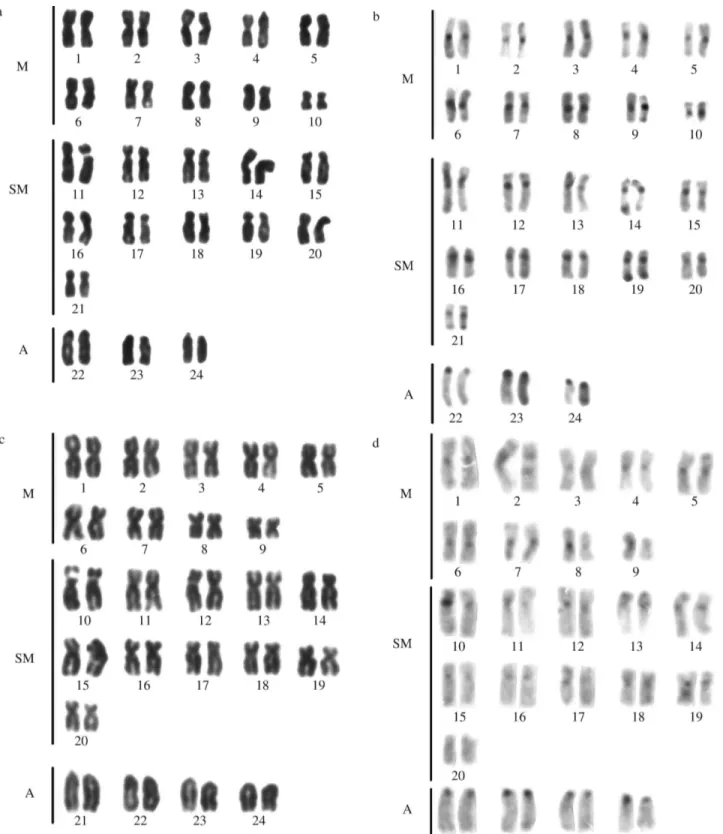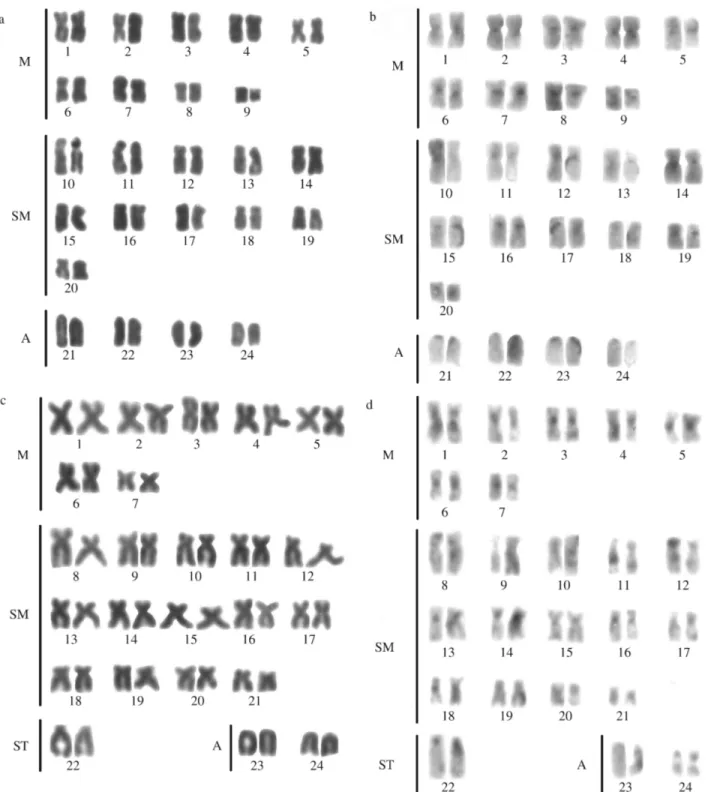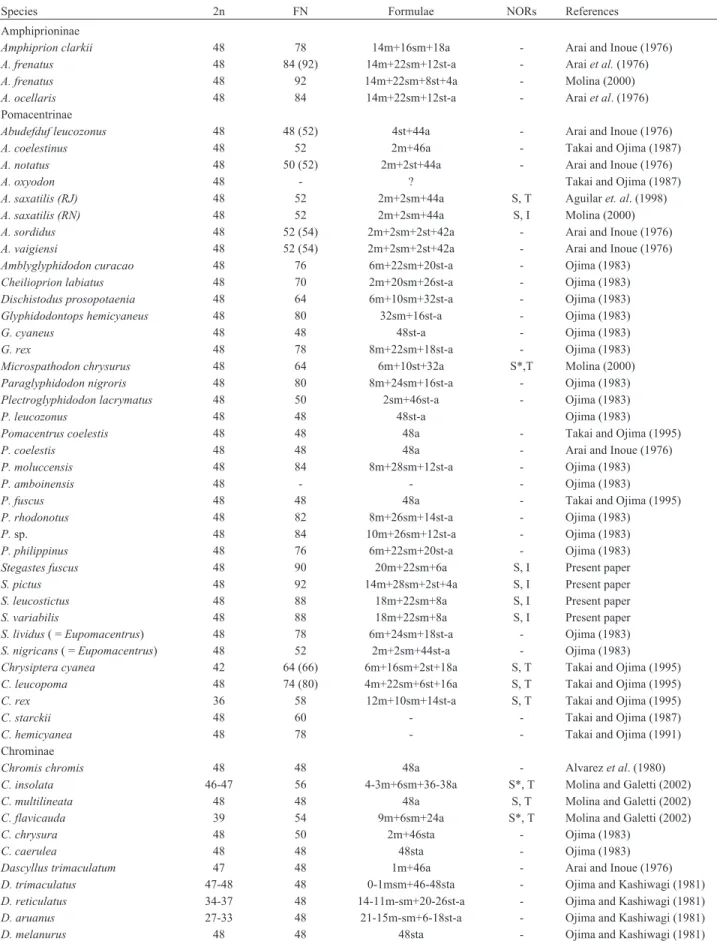Multiple pericentric inversions and chromosomal divergence in the reef fishes
Stegastes
(Perciformes, Pomacentridae)
Wagner Franco Molina
1and Pedro Manoel Galetti Jr.
2 1Universidade Federal do Rio Grande do Norte, Departamento de Biologia Celular e Genética,
Natal, RN, Brazil.
2
Universidade Federal de São Carlos, Departamento de Genética e Evolução, São Carlos, SP, Brazil.
Abstract
Damselfishes (Pomacentridae, Perciformes) occur in all major oceans of the world and, with approximately 320 species, represent one of the most diverse families of marine Teleostei. The taxonomy of these reef fishes is problematic because of the large number of complex species and the range of color patterns they display, which vary among individuals and populations of the same species. In this study, we examined the cytogenetic composition of four species ofStegastes (S. pictus, S. fuscus, S. variabilis and S. leucostictus) found along the coast of Brazil. Stegastes pictus had a chromosomal number of 2n = 48 (14m+28sm+2st+4a, fundamental number (FN) = 92), S. fuscus had 2n = 48 (20m+22sm+6a, FN = 90), S. variabilis had 2n = 48 (18m+22sm+8a, FN = 88), and S. leucostictus had 2n = 48, (18m+22sm+8a, FN = 88). The nucleolar organizing regions were single and homologous in all of the species, and were located in the interstitial region on the short arm of the first submetacentric pair. The heterochromatin segments were reduced in size and were distributed conservatively over the centromeric and pericentromeric regions of most of the chromosomes. The marked divergence in the number of chromosomal arms, compared to other Perciformes (2n = 48, FN = 48), indicated that varying degrees of multiple pericentric inversions had occurred during the karyotypic evolution of the Pomacentridae. Subtle karyotypic differences between S. variabilis and S. leucostictus suggested a recent divergence or that their karyotypes were less susceptible to changes. These results indicate that cytogenetic analyses could provide important complementary data for the characterization of populations and species ofStegastes and damselfishes in general.
Key words:pericentric inversions, pomacentridae,Stegastes, 5S genes. Received: August 14, 2003; Accepted: June 3, 2004.
Introduction
The family Pomacentridae (Perciformes) contains 28 genera and approximately 320 species known as damsel-fishes. This family is one of the most diverse among marine teleosts and occurs in tropical, sub-tropical, and temperate regions of all the major oceans (Nelson, 1994). The taxon-omy of damselfishes is complicated by the large number of complex species and the color patterns that vary among in-dividuals and populations of the same species. Several spe-cies are of growing economic interest because of their diverse color patterns, and this has led to their exploitation.
Several reports have provided karyotypic descrip-tions for the Pomacentridae, especially from the Pacific re-gion, which has the greatest variety of damselfishes (Ojima, 1983; Klinkhardtet al., 1995). However, very little
is known about structural aspects of the karyotype, such as the heterochromatic patterns and the number, position and frequency of the nucleolar organizing regions (NORs).
In this work, the karyotypes of the damselfishes Stegastes fuscus,S. pictus,S. variabilis, andS. leucostictus found along the coast of Brazil have been described. FISH with probes of the ribosomal 5S subunit were used on the speciesS. fuscusandS. variabilis, and rDNA 18S probes on S. fuscus.
Material and Methods
Cytogenetic analyses were done using 24Stegastes fuscus(11 males and 13 females) and sevenS. variabilis(4 males and 3 females) from the coast of the State of Rio Grande do Norte in northeastern Brazil, and four S. leucostictus(2 juveniles, 1 female and 1 male) and fiveS. pictus(3 males and 2 females) collected off the coast of the State of Bahia in northeastern Brazil. Voucher specimens were deposited in the Museum of Zoology of the
Univer-Genetics and Molecular Biology, 27, 4, 543-548 (2004) Copyright by the Brazilian Society of Genetics. Printed in Brazil www.sbg.org.br
Send correspondence to Wagner Franco Molina. Universidade Federal do Rio Grande do Norte, Departamento de Genética e Biologia Molecular, Campus Universitário, 59078-970 Natal, RN, Brazil. E-mail: molinawf@yahoo.com.br.
sidade Federal da Paraíba. Chromosomal preparations were obtained from kidney tissue dissociated in 9.5 mL of RPMI 1640 culture medium with five drops of colchicine for 30 min followed by hypotonic treatment for 25 min at room temperature. The material was then fixed in methanol:
ace-tic acid (3:1, v/v). The NORs and the heterochromaace-tic re-gions were identified by the methods of Howell and Black (1980) and Sumner (1972), respectively. Fluorescencein situ hybridization (FISH) was done in S. fuscus and S. variabilisusing a probe from the 5S rRNA gene of the fish
544 Molina and Galetti Jr.
Leporinus elongatus(Anostomidae, Characiformes) (Mar-tins and Galetti, 1999). An 18S rDNA probe was obtained from total DNA of Prochilodus affinis (Characiformes) (kindly provided by Dr. T. Hatanaka - Universidade Fed-eral de São Carlos) by PCR amplification using the probes NS1 (5’-GTAGTCATATGCTTGTC TC-3’) and NS8 (5’-TCCGCAGGTTCACCTACGGA-3’) (White et al.,
1990; Hizume, 1994). This rDNA probe was used to inves-tigate the major ribosomal sites inS. fuscus.
Results
Stegastes fuscus (20m+22sm+6a), S. variabilis (18m+22sm+8a) (Figure 1),S. leucostictus (18m+22sm+ 8a), and S. pictus (14m+28sm+2st+4a) (Figure 2) had
Pericentric inversions and chromosomal divergence inStegastes 545
2n = 48 and an elevated number of chromosomal arms (FN = 90, 88, 88 and 92, respectively). The hetero-chromatic regions were distributed in the centromeric and pericentromeric portions in most of the chromosomal pairs, with blocks that were more evident in the secondary con-striction (Figures 1 and 2). NORs occurred at an interstitial position on the short arm of the largest submetacentric pair (pair 11 inS. fuscus, 10 inS. variabilisandS. leucostictus, and 12 inS. pictus) (Figure 3). InS. fuscus, hybridization with the 5S rDNA probe identified sequences located inter-stitially on the short arms of two unidentified chromosomal pairs, with one of these pairs having marks that were more evident than in the other. In contrast, signals were detected on only a single pair of chromosomes inS. variabilis (Fig-ure 4). InS. fuscus, FISH using the 18S rDNA probe con-firmed the sites identified by silver staining (Figure 4).
Discussion
The cytogenetic data currently available for marine Perciformes indicates a high degree of chromosomal con-servation in which a large number of species show only mi-nor deviations in the chromosomal organization and fundamental number. A karyotype with 48 chromosomes is considered ancestral for the Teleosts (Ohno, 1974), and oc-curs in 211 of the 660 Perciformes species analyzed so far (Klinkhardtet al., 1995).
Almost all of the species of Pomacentridae that have been analyzed cytogenetically have 2n = 48, with funda-mental numbers that vary between 48 and 92 (Table 1). A karyotype with 2n = 48 and FN = 48, considered ancestral in the group, has been observed in only a few species, such asPomacentrus coelestis(Arai and Inoue, 1976),Chromis chromis(Alvarezet al., 1980) andC. multilineata(Molina and Galetti, 2002). Some representatives of the subfamily Chrominae show marked numerical polymorphism in their chromosomes while maintaining the number of chromo-somal arms. This pattern suggests Robertsonian fusion in the karyotypic evolution of this group. Nevertheless, only 10% of the family has diploid values below the basal num-ber. Despite the importance of polymorphism, this does not appear to be the main evolutionary tendency in the
karyotype of this family, but may be characteristic of specific groups.
Even with a conserved chromosomal number there is considerable variation in the FN values in this family. This finding is a strong indication that pericentric inversions probably play an important role in the karyotypic diversifi-cation of this group of fish. Very little is known about struc-tural aspects of the karyotype in the Pomacentridae. The first indications of C-banding in the Pomacentridae showed a pattern with reduced heterochromatic regions that was ba-sically restricted to centromeric and pericentric areas. This pattern is common to most Perciformes analyzed so far (Galettiet al., 2000; Molinaet al., 2002), and seems to define an array of characteristics that is common to karyo-types with little heterochromatin. A small content of heterochromatin appears to reduce or eliminate the dynam-ics provided by the heterochromatic segments in the karyotype of a given species. One of the most evident con-sequences of this small content of heterochromatin is the presence of single NORs in Perciformes and their limited distribution in the karyotype.
The occurrence of two chromosomal pairs with sites for the 5S rRNA gene inS. fuscusrepresents a derived con-dition in fish (Martins and Galetti, 1999). The presence of only one site inS. variabilismay reflect the fact that some sites are so small that they are incapable of emitting a de-tectable signal. Most probably, however, this single site represents an ancestral condition. Other species of this fam-ily have a single 5S rDNA locus,e.g. Abudefduf saxatilis, or two loci for the 5S gene, as inChromis insolata and Chromis flavicauda(Molina and Galetti, 2002). In the lat-ter two species, the 5S sequences are located in the
546 Molina and Galetti Jr.
Figure 3- NOR-bearing chromosomes. Giemsa and Ag-NOR staining. Note the NORs in an interstitial position on the short arm in pair 11 inS. fuscus(a), in pair 10 inS. variabilis(b) andS. leucostictus(c), and in pair 8 inS. pictus(d).
Pericentric inversions and chromosomal divergence inStegastes 547
Table 1- Chromosome numbers in the family Pomacentridae.
Species 2n FN Formulae NORs References
Amphiprioninae
Amphiprion clarkii 48 78 14m+16sm+18a - Arai and Inoue (1976)
A. frenatus 48 84 (92) 14m+22sm+12st-a - Araiet al.(1976)
A. frenatus 48 92 14m+22sm+8st+4a - Molina (2000)
A. ocellaris 48 84 14m+22sm+12st-a - Araiet al. (1976)
Pomacentrinae
Abudefduf leucozonus 48 48 (52) 4st+44a - Arai and Inoue (1976)
A. coelestinus 48 52 2m+46a - Takai and Ojima (1987)
A. notatus 48 50 (52) 2m+2st+44a - Arai and Inoue (1976)
A. oxyodon 48 - ? Takai and Ojima (1987)
A. saxatilis (RJ) 48 52 2m+2sm+44a S, T Aguilaret. al. (1998)
A. saxatilis (RN) 48 52 2m+2sm+44a S, I Molina (2000)
A. sordidus 48 52 (54) 2m+2sm+2st+42a - Arai and Inoue (1976)
A. vaigiensi 48 52 (54) 2m+2sm+2st+42a - Arai and Inoue (1976)
Amblyglyphidodon curacao 48 76 6m+22sm+20st-a - Ojima (1983)
Cheilioprion labiatus 48 70 2m+20sm+26st-a - Ojima (1983)
Dischistodus prosopotaenia 48 64 6m+10sm+32st-a - Ojima (1983)
Glyphidodontops hemicyaneus 48 80 32sm+16st-a - Ojima (1983)
G. cyaneus 48 48 48st-a - Ojima (1983)
G. rex 48 78 8m+22sm+18st-a - Ojima (1983)
Microspathodon chrysurus 48 64 6m+10st+32a S*,T Molina (2000)
Paraglyphidodon nigroris 48 80 8m+24sm+16st-a - Ojima (1983)
Plectroglyphidodon lacrymatus 48 50 2sm+46st-a - Ojima (1983)
P. leucozonus 48 48 48st-a Ojima (1983)
Pomacentrus coelestis 48 48 48a - Takai and Ojima (1995)
P. coelestis 48 48 48a - Arai and Inoue (1976)
P. moluccensis 48 84 8m+28sm+12st-a - Ojima (1983)
P. amboinensis 48 - - - Ojima (1983)
P. fuscus 48 48 48a - Takai and Ojima (1995)
P. rhodonotus 48 82 8m+26sm+14st-a - Ojima (1983)
P.sp. 48 84 10m+26sm+12st-a - Ojima (1983)
P. philippinus 48 76 6m+22sm+20st-a - Ojima (1983)
Stegastes fuscus 48 90 20m+22sm+6a S, I Present paper
S. pictus 48 92 14m+28sm+2st+4a S, I Present paper
S. leucostictus 48 88 18m+22sm+8a S, I Present paper
S. variabilis 48 88 18m+22sm+8a S, I Present paper
S. lividus( =Eupomacentrus) 48 78 6m+24sm+18st-a - Ojima (1983)
S. nigricans( =Eupomacentrus) 48 52 2m+2sm+44st-a - Ojima (1983)
Chrysiptera cyanea 42 64 (66) 6m+16sm+2st+18a S, T Takai and Ojima (1995)
C. leucopoma 48 74 (80) 4m+22sm+6st+16a S, T Takai and Ojima (1995)
C. rex 36 58 12m+10sm+14st-a S, T Takai and Ojima (1995)
C. starckii 48 60 - - Takai and Ojima (1987)
C. hemicyanea 48 78 - - Takai and Ojima (1991)
Chrominae
Chromis chromis 48 48 48a - Alvarezet al. (1980)
C. insolata 46-47 56 4-3m+6sm+36-38a S*, T Molina and Galetti (2002)
C. multilineata 48 48 48a S, T Molina and Galetti (2002)
C. flavicauda 39 54 9m+6sm+24a S*, T Molina and Galetti (2002)
C. chrysura 48 50 2m+46sta - Ojima (1983)
C. caerulea 48 48 48sta - Ojima (1983)
Dascyllus trimaculatum 47 48 1m+46a - Arai and Inoue (1976)
D. trimaculatus 47-48 48 0-1msm+46-48sta - Ojima and Kashiwagi (1981)
D. reticulatus 34-37 48 14-11m-sm+20-26st-a - Ojima and Kashiwagi (1981)
D. aruanus 27-33 48 21-15m-sm+6-18st-a - Ojima and Kashiwagi (1981)
D. melanurus 48 48 48sta - Ojima and Kashiwagi (1981)
pericentromeric region of two pairs involved in a Robertsonian fusion.
In contrast to other fish groups (Galettiet al., 1984), the NORs were not very informative cytotaxonomic mark-ers in theStegastesspecies examined here. FISH using an 18S rDNA probe confirmed the location of the major ribo-somal sites identified by silver staining inS. fuscus.In this group, maintenance of the rDNA cluster on the same chro-mosomal pair among species reflected both the narrow phylogenetic proximity of the species and a lower dyna-mism of the internalized sites in relation to those located in telomeric positions.
Multiple pericentric inversions are an important mechanism of post-zygotic isolation (King, 1992). Events of this magnitude could favor speciation in extremely terri-torial coral species such asStegastes. High fundamental numbers indicate that pericentric inversions in concert are widespread in the karyotypic evolution of the Pomacentrinae and Amphiprioninae. In both of these groups, biological characteristics that regulate the gene flow (territorialism, adhesive eggs and a sessile form) con-tribute to the break/split of the marine environment in de-fined micro-regions that may favor the fixation of chromosomal rearrangements.
The high FN values observed inS. variabilis(88),S. leucostictus(88),S. fuscus(90), andS. pictus(92) suggest the occurrence of rearrangements in chain acting upon the karyotypes of the species. The increase in the fundamental numbers seen here may be indicative of different levels of phylogenetic relationship among the species analyzed.
Acknowledgements
This work was supported by the Coordenação de Aperfeiçoamento de Pessoal de Nível Superior (CAPES) and Conselho Nacional de Desenvolvimento Científico e Tecnológico (CNPq), Brazil.
References
Aguilar CT and Galetti Jr. PM (1997) Chromosomal studies in South Atlantic serranids (Pisces, Perciformes). Cytobios 89:105-114.
Alvarez MC, Cano J and Thode G (1980) DNA content and chro-mosome complement ofChromis chromis(Pomacentridae, Perciformes). Caryologia 33:267-274.
Arai R and Inoue M (1976) Chromosomes of seven species of Pomacentridae and two species of Acanthuridae from Japan Bull Natn Sci Mus Ser A2, 73-78.
Arai R, Inoue M and Ida H (1976) Chromosomes of four species of coral fishes from Japan. Bull Natn Sci Mus Ser A2, 137-141.
Galetti Jr PM, Aguilar CT and Molina WF (2000) An overview on marine fish cytogenetics. Hydrobiologia 420:55-62.
Galetti Jr PM, Foresti F, Bertollo LAC and Moreira FO (1984) Characterization of eight species of Anostomidae (Cypriniformes) fish on the basis of the nucleolar organizing region. Caryologia 37:401-406.
Howell WM and Black A (1980) Controlled silver staining of nu-cleolus organizer regions with protective colloidal devel-oper: 1- step method. Experientia 36:1014-1015.
Hizume M (1994) Allodiploid nature ofAllium wakegiAraki re-vealed by genomicin situhybridization and localization of 5S and 18S rDNAs. Jpn J Genet 69:407-415.
King M (1992) A dual level model for speciation by multiple pericentric inversions. Heredity 68:437-440.
Klinkhardt M, Tesche M and Greven H (1995) Database of Fish Chromosomes. Westarp Wissenschaften, Magdeburg. Martins C and Galetti Jr PM (1999) Chromosomal localization of
5S rDNA genes in Leporinus fish (Anostomidae, Characiformes). Chromosome Res 7:363-367.
Molina WF (2000) Análise da diversidade genética em Pomacentridae (Perciformes), através do uso combinado da citogenética, marcadores moleculares e morfometria multi-variada. PhD Thesis, Universidade Federal de São Carlos, São Carlos.
Molina WF, Affonso PRAM and Maia-Lima FA (2002) Diver-gence between karyotypical pattern and speciation events in Serranidae fish (Perciformes). Caryologia 55:299-305. Molina WF and Galetti Jr PM (2002) Robertsonian
rearrange-ments in the reef fish Chromis (Perciformes, Pomacentridae) involving chromosomes bearing 5S rRNA genes. Genet Mol Biol 25:373-377.
Nelson JS (1994) Fishes of the World. 3rd edition. John Wiley & Sons Inc., New York.
Ohno s (1974) Animal Cytogenetics. Chordata 1 - Protochordata, Cyclostomata and Pisces. v. 4. Gebrüder Burntraeger, Berlin.
Ojima Y (1983) Fish cytogenetics. In: Sharma AK and Sharma A (eds) Chromosomes in Evolution of Eukaryotic Groups. v. 1. CRC Press, Boca Raton, pp 111-145.
Ojima Y and Kashiwagi E (1981) Chromosomal evolution associ-ated with Robertsonian fusion in the genus Dascyllus
(Chrominae, Pisces). Proc Jap Acad 57B:368-70.
Sumner AT (1972) A simple technique for demonstrating centromeric heterochromatin. Exp Cell Res 75:304-306. Takai A and Ojima Y (1987) Comparative studies of karyotypes
and distribution of nucleolus organizer regions in pomacentrid fish. 1. Proc Jap Acad 63b:17-20.
Takai A and Ojima Y (1991) Comparative studies of karyotypes and distribution of nucleolus organizer regions in pomacentrid fish. 2. Cytobios 65:199-205.
Takai A and Ojima Y (1995) Chromosome evolution associated with Robertsonian rearrangements in pomacentrid fish (Perciformes). Cytobios 84:103-110.
White TJ, Bruns T, Lee S and Taylor J (1990) Amplification and direct sequencing of fungal ribosomal RNA genes for phylogenetics. In: Innis MA, Gelfand DH, Sninsky JJ and White TJ. (eds) PCR Protocols: A Guide to Methods and Applications. Part 3. Academic Press, New York, pp 315-322.
Associate Editor: Fausto Foresti



